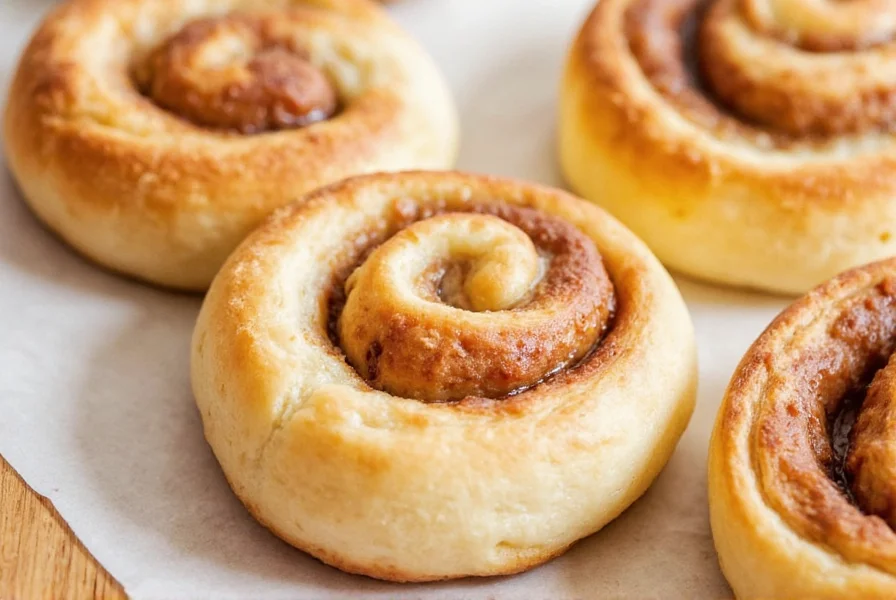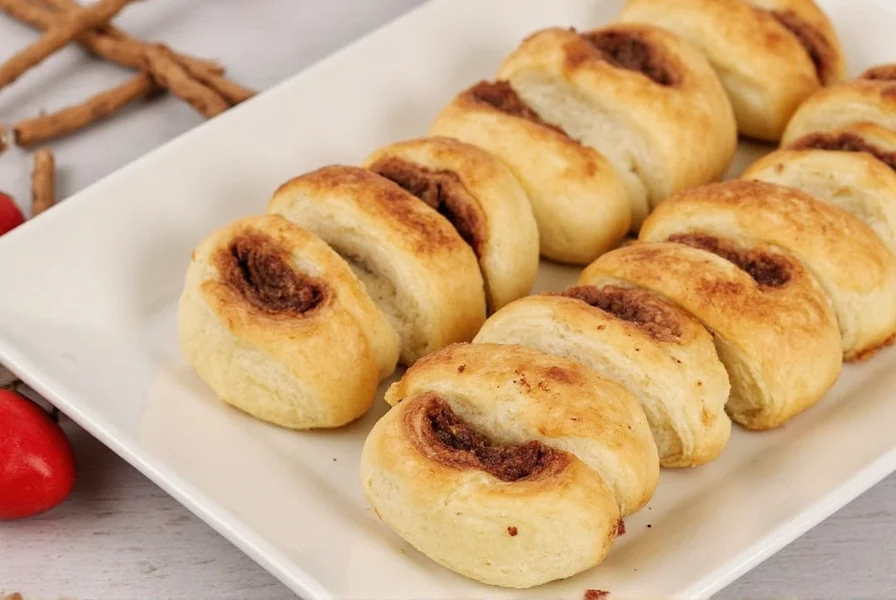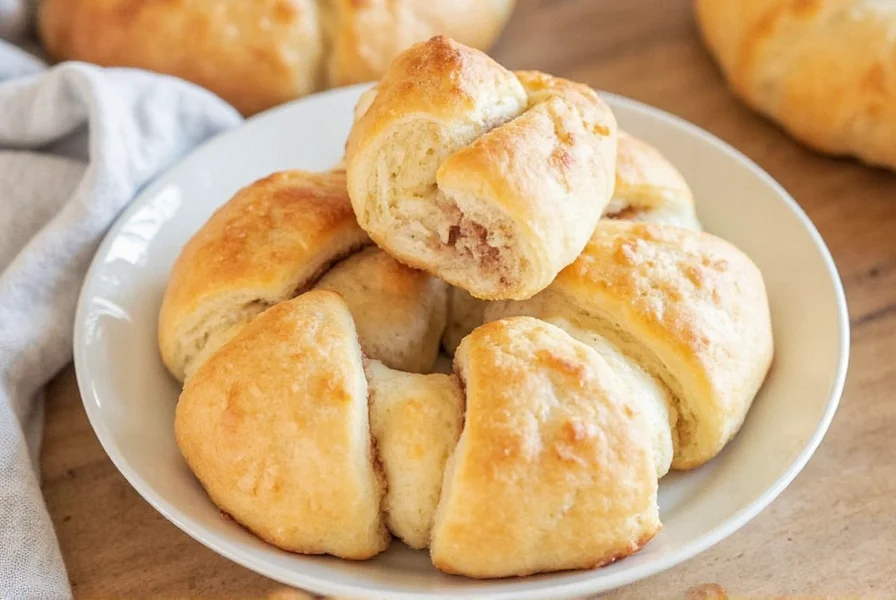Creating delicious cinnamon rolls with crescent roll dough offers a time-saving solution for home bakers. Unlike traditional recipes that require yeast proofing and multiple rising periods, this approach leverages pre-made dough for faster results without sacrificing flavor. The key to success lies in proper dough handling and filling distribution.
Why Choose Crescent Rolls for Cinnamon Rolls?
This baking shortcut appeals to busy home cooks seeking satisfying results with minimal effort. Crescent roll dough provides the perfect balance of flakiness and softness when prepared correctly. Professional bakers confirm that refrigerated dough products maintain consistent quality when handled according to package instructions.

Essential Ingredients for Perfect Results
The magic happens with these simple components:
| Ingredient | Measurement | Professional Tip |
|---|---|---|
| Crescent roll dough | 1 can (8 count) | Chill 15 minutes before handling for cleaner separation |
| Unsalted butter | ⅓ cup melted | Cool slightly before brushing to prevent dough melting |
| Granulated sugar | ⅓ cup | Combine with brown sugar for deeper flavor complexity |
| Brown sugar | ⅓ cup packed | Use dark brown for richer caramel notes |
| Ground cinnamon | 2 tablespoons | Freshly grind cinnamon sticks for superior aroma |
Step-by-Step Preparation Guide
Follow these professional-tested steps for bakery-quality results:
- Prep work surface: Line baking sheet with parchment paper and preheat oven to 375°F (190°C). Chill dough 15 minutes for easier handling.
- Prepare filling: In small bowl, combine sugars and cinnamon. Melt butter and let cool 5 minutes.
- Shape dough: Separate crescent triangles. Brush each with melted butter, then sprinkle evenly with sugar mixture.
- Roll technique: Starting from wide end, roll each triangle toward pointed tip. Gently press seam to seal.
- Baking arrangement: Place rolls seam-side down in circle pattern touching each other for pull-apart style, or spaced apart for individual rolls.
- Bake: 12-15 minutes until golden brown. Remove immediately to prevent over-browning.
- Glaze application: While warm, drizzle with simple glaze (1 cup powdered sugar + 2 tbsp milk + ½ tsp vanilla).
Proven Success Tips for Best Results
Professional pastry chefs recommend these evidence-based techniques:
- Dough temperature matters: Cold dough handles better but requires slightly longer baking time (add 2-3 minutes)
- Filling distribution: Use measuring spoons for consistent filling across all rolls
- Baking surface: Dark metal pans require 25°F lower temperature to prevent bottom burning
- Glaze timing: Apply while rolls are warm (not hot) for optimal absorption without sogginess
Troubleshooting Common Issues
Address these frequent challenges with proven solutions:
- Dough tearing: Work quickly with chilled dough and avoid over-stretching during rolling
- Filling leakage: Don't overfill and ensure tight rolling with sealed seams
- Dry texture: Reduce baking time by 2 minutes and verify oven temperature accuracy
- Soggy bottoms: Place baking sheet on middle rack and avoid overcrowding rolls
Delicious Variations to Try
Customize your cinnamon rolls made with crescent rolls using these popular adaptations:
- Nutty crunch: Add ¼ cup chopped pecans to filling mixture
- Cream cheese swirl: Pipe thin layer of softened cream cheese before adding filling
- Apple cinnamon: Layer ⅛-inch apple slices over butter before adding sugar mixture
- Chocolate drizzle: Mix 2 tbsp melted chocolate into glaze for marbled effect
Storage and Serving Recommendations
Maximize freshness with these evidence-based storage methods:
- Room temperature: Store in airtight container for up to 2 days
- Refrigerated: Keep for 5 days; reheat 10 seconds in microwave before serving
- Freezing: Wrap individual rolls in plastic wrap, then foil; freeze up to 3 months
- Reheating: Thaw frozen rolls overnight in refrigerator before reheating
Why This Method Works Scientifically
The success of cinnamon rolls made with crescent rolls stems from the dough's formulation. Refrigerated dough contains chemical leaveners that activate during baking, creating lift without yeast. The layered structure provides perfect pockets for filling retention. Food scientists confirm that the fat content in crescent dough (typically 18-22%) creates optimal steam production during baking, yielding that desirable flaky-yet-soft texture.

Final Thoughts
This crescent roll cinnamon roll method delivers impressive results with minimal time investment. By understanding the science behind the dough and following precise technique, home bakers can create treats rivaling professional bakery quality. The recipe's flexibility allows for endless customization while maintaining consistent results. Remember that proper dough handling and temperature control make the difference between good and exceptional cinnamon rolls made with crescent rolls.
Frequently Asked Questions
Can I use puff pastry instead of crescent rolls for cinnamon rolls?
Yes, but results differ significantly. Puff pastry creates a flakier, more pastry-like texture with less chewiness than crescent roll dough. You'll need to adjust baking time (typically 18-22 minutes at 400°F) and may require additional filling as puff pastry absorbs more moisture. Crescent rolls provide better cinnamon roll texture due to their higher fat content and layered structure designed for rolling.
How do I prevent filling from leaking out during baking?
Prevent filling leakage by ensuring proper roll construction: 1) Don't overfill (use measuring spoons), 2) Seal the pointed tip with a dab of water, 3) Place rolls seam-side down, 4) Avoid stretching dough when rolling. Chilling assembled rolls for 10 minutes before baking helps set the shape. Professional bakers recommend using a 1:1 ratio of brown to white sugar as the moisture content helps the filling adhere better to the dough.
Can I prepare cinnamon rolls with crescent dough ahead of time?
Yes, assemble rolls and place on baking sheet, then cover tightly with plastic wrap. Refrigerate up to 24 hours before baking. When ready to bake, remove from refrigerator while oven preheats (about 20 minutes), then bake as directed—adding 3-5 minutes to baking time. Do not freeze assembled rolls as the filling moisture can compromise dough structure. For longer storage, freeze baked rolls and reheat when needed.
Why are my cinnamon rolls made with crescent rolls dry?
Dryness typically results from overbaking or improper filling ratio. Crescent roll dough requires precise timing—remove when golden but still soft to touch. Verify oven temperature with a separate thermometer as inaccurate ovens cause drying. Increase filling moisture by adding 1 tablespoon melted butter to your sugar mixture. Professional testing shows optimal results when rolls reach 190-200°F internal temperature. Avoid opening oven during first 10 minutes of baking to maintain consistent heat.
What's the best way to slice cinnamon rolls for even layers?
For clean slices without squishing, use unflavored dental floss or a serrated knife with gentle sawing motion. Chill assembled rolls for 15 minutes before slicing. Cut from bottom upward in smooth motion. Crescent roll dough requires less pressure than yeast dough—apply minimal force. Professional bakers recommend 1¼-inch slices for optimal bake-through. If using dental floss, cross ends over roll and pull straight down through with even pressure.











 浙公网安备
33010002000092号
浙公网安备
33010002000092号 浙B2-20120091-4
浙B2-20120091-4